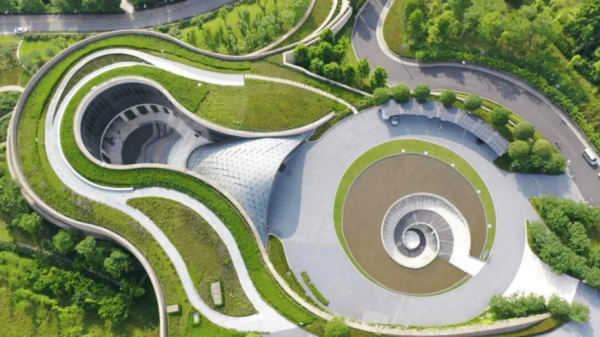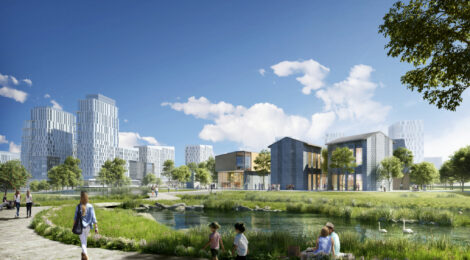
Green Chongqing 2 – The Sponge City Initiative and its Implementation in Chongqing
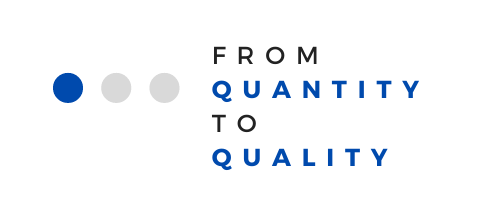
If we look at China in the past forty and more years of intensive economic growth, we can see how one of the main growing tendencies is that of urbanization. Chinese cities are actors for change. In this way, in the urban platforms new programmes can be implemented: Chinese megalopolis have huge territories, millions of potential users and customers, and they can represent the first level of policy implementation. For this reason, also in the national Chinese race of becoming a green country, cities can play a role and represent grounds for testing and implementing green policies and strategies.
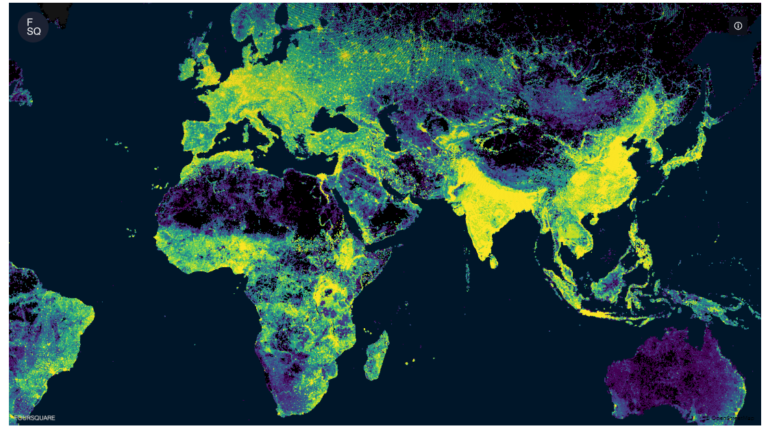
Urbanization globally (with a focus on Eurasia)
1. Intensive urbanization and its impact on the environment
Cities have been the center of growth in China but they also had a huge impact on the environment. In the past decades rapid urbanization in the country has caused severe water and environmental problems. As underlined by iChongqing, China has in fact urbanized on an unprecedented scale, with the country’s urbanization rate increasing from 17.55% in 1977 to 60.60% in 2019. Rapid urbanization comes hand-in-hand with the country’s extraordinary economic boom, but cities are built at the expense of green spaces, therefore posing significant challenges for flood management.
Intensive and hard urbanization can bring many problems on the table: from wastewater infrastructures, urban flooding, combined severe overflow, water quality deterioration, water scarcity, high frequency of extreme weather. These problems can bring an enormous impact on the economy, environment, city infrastructure and human society.

The impressive floods in Chongqing in 2022
2. The introduction of the “Sponge City Initiative” and its development national wide
To resolve this issue, one of the strategies launched by the Chinese government was a sponge city construction programme in 2015 (Li, Ding, Ren, Li, Wang, 2017). The sponge city concept was firstly proposed by Chinese researchers in 2013 and Professor Kongjian Yu is the mastermind behind it.
In a speech at the Central Government Work Conference on Urbanization in December 2013, Chinese President Xi Jinping endorsed the term “sponge City” for the first time. “When upgrading the urban drainage system, priority should be given to retaining rainwater and using the power of nature to drain it. We should build sponge cities with natural drainage, retention, penetration, and purification systems for water,” Xi said.
Subsequently, the State Council issued the “Guideline on Promoting the Construction of Sponge City”, which set the goal that sponge cities will collect and utilize 70 percent of the rainwater, with 20 percent of urban areas meeting the target by 2020 and 80 percent by 2030.
According to Li, Ding, Ren, Li and Wang, the programme was then launched at the end of 2014, under the guidance and support of three ministries, respectively the Ministry of Housing and Rural-Urban Development (UHURD), Ministry of Finance (MOF) and Ministry of Water Resources (MWR). In April 2015 the first group of 16 cities was selected while one year later, in April 2016, the number was expanded with another 14 cities. The Central Government allocated to each pilot city between 400 and 600 million Chinese Yuan (RMB) each year for three consecutive years. In 2017, “Sponge City” was even officially stated in the Chinese government work report, becoming a hot topic at all levels of government throughout that year.
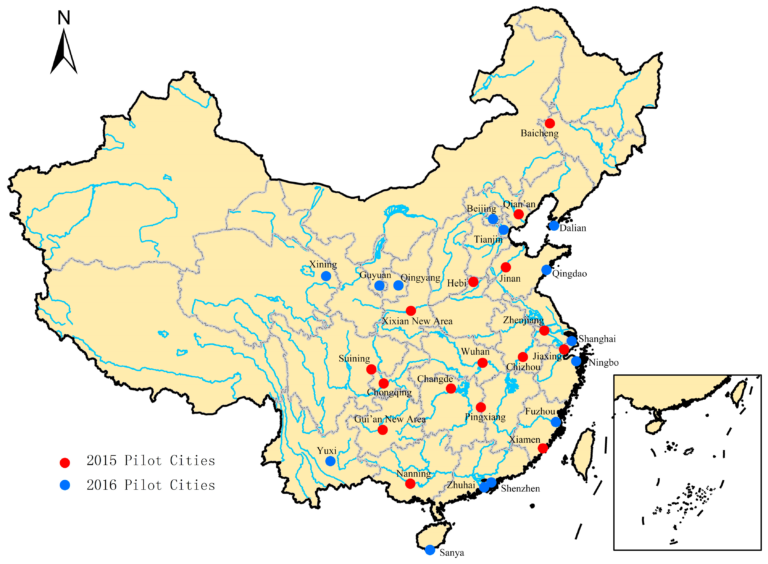
The Sponge pilot cities in 2015 and 2016
3. But what is a Sponge City?
As underlined by Euronews.green, a ‘sponge city’ is a nature-based solution which uses the landscape to retain water at its source, slow down water flow and clean it throughout the process. The focus is to retain rainwater in urban areas by waterproofing the paved floor so that part of it evaporates and the rest is gradually drained. As well as proofing the roads and pavements, more trees are planted and smart buildings are constructed to adapt to the city’s sponge. This means roofs are covered in grass for greater absorption of water and buildings are also painted in light colors to reflect more heat instead of absorbing it. Scientifically speaking, the main features of the sponge city include being: environmentally adaptive, systematic and comprehensive and environmentally friendly.
“The sponge city is a system, just like the blood in the human body. Each sponge project is like the cells in the human body. The various pipe networks are capillaries, which are responsible for the transportation of rainwater” states Mo Tianzhu, Deputy Director of the Pipeline Center of the Chongqing Municipal Housing and Urban-Rural Construction Committee. The logic of the sponge city is that after the collection and filtration of each sponge project, the rainwater flows into the pipe network and then converges into lakes and rivers. “Retain and purify layer by layer from the source, while reducing the burden on the pipe network, the water discharged into rivers and lakes will also be cleaner“
“Actually, the mountains, forests and grasslands are the best sponges. After being filtered by nature, the discharged water will naturally be much cleaner” Mo Tianzhu said.
4. The Chongqing “sponge city” implementation
In May of 2022, the Ministry of Housing and Urban-Rural Development issued the “Notice on Further Clarifying the Relevant Requirements for the Construction of Sponge Cities”, which clarified that the construction of sponge cities should be problem-oriented.
Chongqing is one of the first batch of pilot cities in the country. Since 2015, the Municipality has realized the sponge city “from scratch” and built a number of sponge city projects.
Starting from 2022, the construction focus of Chongqing Sponge City has shifted from project construction to regional construction level, gradually realizing “from existence to improvement”. “The current key work is to adapt measures to local conditions and advance systematically to form their own typical drainage zones in districts and counties. By implementing the concept of sponge in each drainage zone, a regional sponge development path will be formed according to local conditions, forming a complete system from source to end. The system will give full play to the concatenation effect, and systematically promote the construction of sponge cities from point to surface” Mo Tianzhu told us.
“The Ministry of Housing and Urban-Rural Development has made it clear that sponge city is a construction concept. The purpose is to form a safe, comfortable and sustainable urban water circulation system, relieve urban waterlogging, and purify the urban water environment.” told us Mister Tianzhu during our interview.
The first is the prevention and control of waterlogging, which is a safety issue for the city and is the bottom line; the second is the treatment of black water bodies in the city, which can improve the comfort of ordinary people’s lives; the third is the sustainable development of the sponge city ecology, and the construction of the urban water system should be coordinated. Requirements from all aspects, while based on the present, benefit future generations. “The construction of the sponge city does not have an independent sponge project. The sponge concept is implemented simultaneously with the roof, roads, landscape and other carriers of the construction project. All kinds of equipment and facilities are required to have a lower impact on the environment during the construction process.”
At present, Chongqing has formed many characteristic regional sponges. For example, the “Mountain Sponge” in the Yuelai area of Liangjiang New District uses the slope of the mountain to filter rainwater through layers of vegetation and design rainwater pools to collect rainwater; the “Big Sponge” in Bishan opens up various water systems, allowing its internal circulation to purify water quality . In addition, the “Global sponge” in Xiushan County implements global management and control over the urban planning area, from permeable pavement to roof greening, rainwater disconnection, bio-retention belts, rainwater gardens, and silica sand storage tanks.
As of 2021, the cumulative area of Chongqing Sponge City is 521.1 square kilometers, accounting for 29.8% of the city’s built-up area. By 2025, it will reach 45%, and by 2030 it will reach 80%.
According to this requirement, the area up to the standard of Chongqing Sponge City will increase by more than 5% every year. “The difficulty is that the area of urban built-up areas is also increasing, and the task is arduous.”
Currently, Chongqing’s urban built-up area is increasing by about 3% every year, and it is expected to exceed 1,800 square kilometers this year. According to the arrangement of the Chongqing Municipal Housing and Urban-Rural Construction Committee, this year, the city plans to implement 263 drainage zones with an area of about 536 square kilometers.
Written by Marco Bonaglia
Please share:




